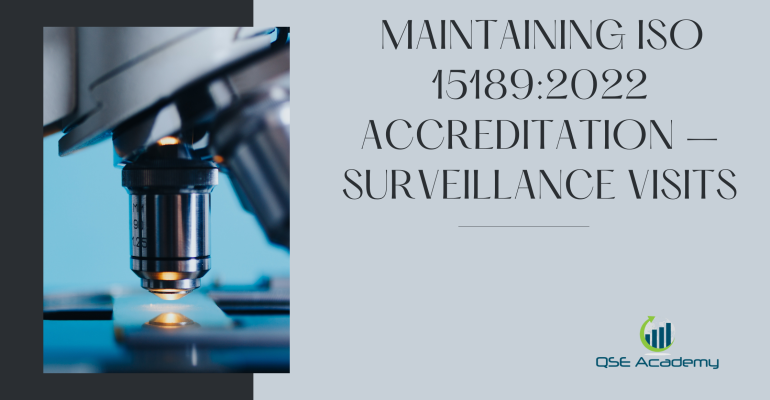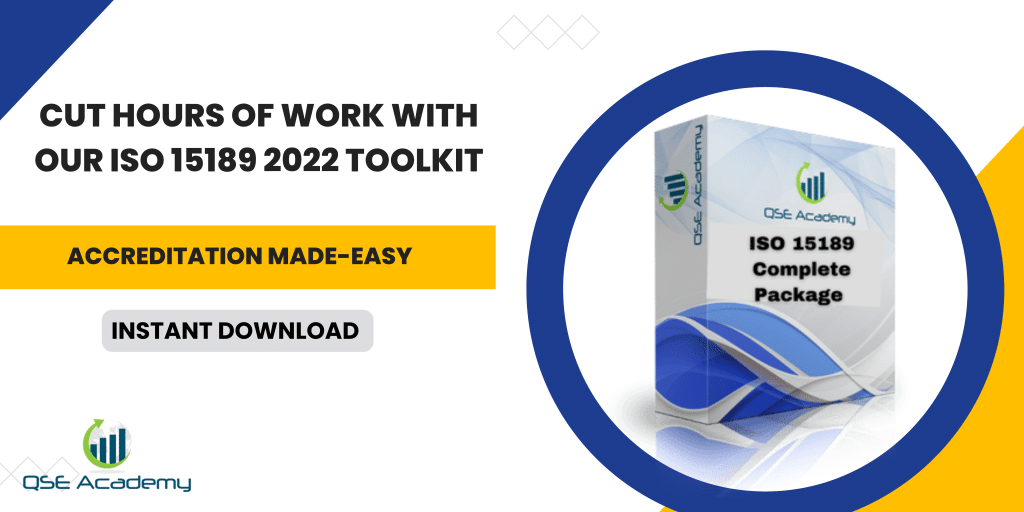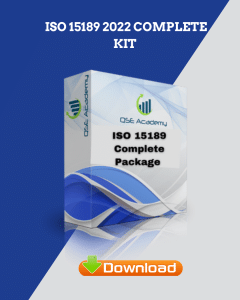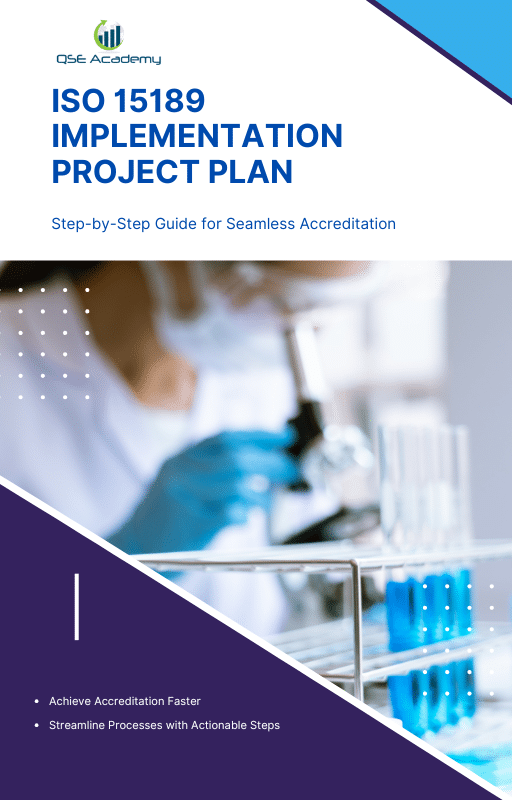Maintaining ISO 15189:2022 Accreditation – Surveillance Visits

Maintaining ISO 15189:2022 Accreditation – Surveillance Visits
Last Updated on October 22, 2025 by Hafsa J.
Accreditation Doesn’t End with the Certificate
Getting accredited to ISO 15189:2022 feels like crossing the finish line — until you realize it’s just the start of a new race. Many labs work tirelessly to earn that first certificate, only to relax too soon and get caught off guard during the next surveillance visit.
Here’s what I’ve seen over the years: the labs that treat accreditation as a one-time project often struggle to keep it. The ones that treat it as part of their culture? They pass surveillance visits with ease.
In this guide, we’ll break down exactly how surveillance visits work — what they are, what assessors look for, and how to stay ready all year long. You’ll learn how to prepare, respond to findings, and keep your accreditation strong without the last-minute scramble.
Let’s start with the basics: what a surveillance visit actually is and why it matters more than most labs realize.
What Is a Surveillance Visit and Why It Matters
A surveillance visit is your accreditation body’s way of checking that your laboratory is still doing what it promised to do when it earned its ISO 15189:2022 certificate. It’s not another full accreditation audit — it’s a periodic checkup to make sure your quality management system is alive, active, and improving.
These visits usually happen once every 12 to 18 months, depending on your accreditation body. Assessors look at selected areas of your system to confirm you’re maintaining compliance, implementing corrective actions, and keeping staff competence and equipment calibration up to date.
Here’s why it matters:
-
It protects your credibility. Regular surveillance assures your clients and regulators that your lab still produces valid, trustworthy results.
-
It prevents suspension. Accreditation can be withdrawn if the lab fails to maintain its system or ignores nonconformities.
-
It helps you improve. Each visit gives your team real-world feedback from experienced assessors.
Pro Tip: Treat every surveillance visit like a “mini-accreditation.” The more consistent your daily operations, the less you’ll need to prepare before an audit.
Common pitfall: Thinking surveillance visits are less serious than the initial accreditation. Assessors often go deeper the second time — because now they want to see if your system actually works over time.
Next, let’s break down what the typical surveillance cycle looks like so you can see where it fits in your overall accreditation plan.
The Typical ISO 15189 Surveillance Cycle
Once your lab earns its accreditation certificate, the clock starts ticking on the surveillance cycle. These follow-up visits aren’t random — they follow a structured timeline set by your accreditation body to make sure your quality management system stays strong.
Here’s what that timeline usually looks like:
| Phase | Purpose | Timing |
|---|---|---|
| Initial Accreditation | Full system and technical evaluation | Year 0 |
| 1st Surveillance | Partial review of selected processes and records | Year 1 |
| 2nd Surveillance | Review of remaining areas, follow-up on improvements | Year 2 |
| Reassessment | Full re-evaluation to renew accreditation | Year 3 |
By the time you reach the third year, your lab will undergo a complete reassessment — essentially a fresh accreditation audit to renew your certificate for the next cycle.
Pro Tip: Keep your quality management system audit-ready year-round. That means updating records, closing corrective actions promptly, and keeping logs current. It’s much easier than trying to “catch up” two months before a visit.
Surveillance visits may focus on specific sections, but assessors will always expect your overall system to function seamlessly. If one process looks neglected, they’ll dig deeper.
Now that you understand the cycle, let’s talk about what assessors actually look for when they walk through your lab during a surveillance visit.
What Assessors Look for During Surveillance
Surveillance visits are less about paperwork and more about proof — proof that your lab’s system isn’t just documented, but actually working day-to-day. Assessors want to see that your processes are alive, consistent, and continuously improving.
Here’s what they typically focus on during these visits:
-
Internal audits and management reviews: They’ll check whether you’ve completed them on schedule and acted on any findings.
-
Corrective and preventive actions (CAPA): They’ll follow up on previous nonconformities and verify that improvements are effective.
-
Equipment calibration and maintenance: Expect assessors to review logs and verify traceability.
-
Staff competence and training: They’ll want evidence of refresher training, updated qualifications, and performance evaluations.
-
Participation in External Quality Assurance (EQA): Regular proficiency testing is critical — missed cycles can raise red flags.
-
Document control and record management: They’ll confirm you’re keeping version control tight and records accessible.
Example: During one visit, an assessor focused almost entirely on how a lab handled equipment maintenance — not because it was a problem, but because it was a weak area in the previous audit. The lab’s updated calibration program impressed the assessor and cleared a past finding permanently.
Pro Tip: Keep a dedicated Surveillance File (digital or physical). Store everything updated since your last visit — from audit reports and CAPAs to training logs. It’s a lifesaver when assessors ask for evidence on the spot.
Next, let’s walk through how to prepare for a surveillance visit so it feels like a routine checkup, not a crisis.
Preparing for a Surveillance Visit
The best surveillance visits are the ones that feel almost uneventful — not because the assessors skip things, but because your lab stays ready all year. Preparation isn’t about scrambling the month before; it’s about keeping your system active and organized from day one.
Here’s how to prepare effectively:
-
Review previous findings.
Start by looking at your last assessment report. Make sure every corrective action has evidence of completion and follow-up. -
Update your records.
Calibration logs, maintenance checklists, and training files should be current and easy to access. Assessors appreciate efficiency as much as accuracy. -
Conduct an internal audit.
Focus on areas that weren’t heavily reviewed in the last surveillance. This shows continual monitoring of your full system. -
Hold your management review.
Keep it recent — assessors often check that management is actively involved in quality performance and improvement. -
Refresh your team.
Brief your staff on key quality procedures, roles, and how to handle assessor questions. Confidence matters.
Pro Tip: Assign section leaders for each major area (e.g., sample handling, testing, reporting). When assessors ask for evidence, each person knows exactly what to present — no delays, no confusion.
Common pitfall: Waiting for the official notification letter before preparing. By then, you’re already behind. Start reviewing and updating records at least three months before the expected visit.
Once the visit is over, your job isn’t done. Let’s talk about how to handle findings and turn them into ongoing improvement — the part that truly sustains your accreditation.
Handling Findings and Continuous Improvement
Even the best laboratories receive findings during surveillance visits. The difference between a strong lab and a struggling one isn’t whether they get findings — it’s how they respond. Surveillance is about continuous improvement, not punishment.
Here’s how to handle it the right way:
-
Acknowledge findings quickly.
When you receive the report, don’t go quiet. Acknowledge each observation and commit to a response deadline. Accreditation bodies appreciate proactive communication. -
Analyze the root cause.
Don’t just patch the symptom. Ask why the issue happened. Was it a training gap, unclear procedure, or lack of follow-up? Root-cause analysis shows maturity in your system. -
Plan and document corrective actions.
Every nonconformity should have a corrective-action plan that includes what was done, who did it, and how you verified effectiveness. -
Submit evidence on time.
Most ABs expect your responses within 30 days. Missing this deadline can affect your accreditation status — or delay your next certificate renewal.
Example: One lab I worked with turned a surveillance finding about incomplete equipment logs into a full improvement project. They digitized their maintenance records, retrained staff, and by the next visit, the assessors marked it as a model process.
Pro Tip: Track trends. If you see similar issues appearing across multiple audits, that’s a signal to strengthen system-level controls — not just fix isolated problems.
Next, let’s look at what happens when a lab doesn’t keep up — and the common reasons accreditation gets suspended or withdrawn.
Common Reasons Labs Lose Accreditation
Losing accreditation rarely happens overnight — it’s usually the result of small issues that pile up over time. Most labs don’t fail because they don’t know the ISO 15189 requirements; they fail because they stop maintaining them consistently.
Here are the most common reasons I’ve seen labs lose or risk suspension of their ISO 15189 accreditation:
-
Neglecting internal audits and management reviews.
When these activities become irregular or superficial, assessors see it as a breakdown of your quality management system. -
Ignoring nonconformities.
Leaving findings unresolved (or only partially addressed) signals that continuous improvement isn’t happening. -
Letting calibration or maintenance lapses slip.
Even one overdue calibration record can raise questions about test validity — a major red flag for assessors. -
Inconsistent staff competence records.
Assessors expect updated training logs, proficiency test results, and performance assessments. Missing evidence equals lost confidence. -
Communication gaps.
Some labs forget to notify their accreditation body of major changes — like new equipment, staff turnover, or facility moves. That can trigger administrative nonconformities or even suspension.
Pro Tip: Assign a dedicated Accreditation Maintenance Lead — someone responsible for tracking audit schedules, closing actions, and coordinating updates with the accreditation body. It keeps your system active and prevents things from falling through the cracks.
Now that we’ve covered the risks, let’s wrap up with some common questions labs ask about surveillance visits and ongoing accreditation maintenance.
FAQs – Maintaining ISO 15189:2022 Accreditation
1. How often do surveillance visits happen?
Most accreditation bodies conduct surveillance visits every 12 to 18 months, depending on your risk profile, performance, and accreditation agreement. High-performing labs with consistent compliance may occasionally receive extended intervals — but annual reviews are the norm.
2. Can we request to reschedule or postpone a surveillance visit?
Yes, but only for legitimate reasons like staff illness, relocation, or major lab renovations. You’ll need to notify your accreditation body well in advance — usually at least a month before the scheduled date — and provide justification. Frequent postponements can raise concern about system reliability.
3. Do surveillance visits cost the same as the initial accreditation?
Not quite. They’re typically 40–60% of the initial cost, since the assessment covers fewer areas. But remember, costs still include assessor man-days, travel, and report preparation.
4. Will we receive a new certificate after each visit?
No. Your existing certificate remains valid until your next reassessment cycle (typically every three years). Surveillance visits confirm continued compliance but don’t issue new certificates.
5. What happens if we fail a surveillance visit?
You’ll receive nonconformities that must be corrected within a set time frame. Failure to respond or provide sufficient evidence can lead to suspension or withdrawal of accreditation — though most labs recover quickly once corrective actions are verified.
Now that you know what to expect from ongoing assessments, let’s close with a final reminder on how to keep your system active, confident, and always audit-ready.
Keep Your System Alive, Not Just Compliant
Maintaining ISO 15189:2022 accreditation isn’t about surviving each surveillance visit — it’s about building a lab culture where quality never sleeps. The certificate on your wall is just the symbol; what really matters is the system behind it, running smoothly day after day.
In my experience, the labs that breeze through surveillance audits don’t do anything extraordinary. They simply stay consistent. They review records regularly, close findings quickly, train their teams continuously, and treat every audit as a learning opportunity — not a threat.
The real secret? Make quality management part of your routine, not a reaction. When your system stays active, assessors see it immediately. You’ll move through surveillance visits confidently, with fewer findings and more trust from your clients and accreditation body.
If you want to make it easier, download our ISO 15189 Surveillance Preparation Checklist — a simple planning tool that helps you stay ready all year, not just audit season.
Because in the world of accreditation, consistency isn’t just compliance — it’s credibility.
Whether it’s ISO 9001, ISO 22000, or the cosmetics-focused ISO 22716, I’ve spent my career I’m not here to call myself an expert—I prefer “enthusiast” because I truly love what I do. When I’m not writing about standards, you’ll probably find me playing Piano 🎹, connecting with people, or diving into my next big project💫. I’m an engineer specialized in the food and agricultural industry
make ISO standards less intimidating and more approachable for everyone.
turning complex jargon into clear, actionable steps that businesses can actually use.
There’s something incredibly rewarding about helping people navigate food safety and quality management systems
in a way that feels simple, practical, and even enjoyable.
I have a Master’s in QHSE management and over 12 years of experience as a Quality Manager
I’ve helped more than 15 companies implement ISO 9001, ISO 22000, ISO 22716, GMP, and other standards
My clients include food producers, cosmetics manufacturers, laboratories, and service companies
I believe quality systems should be simple, useful, and efficient.
Related Posts
ISO 15189:2022 Accreditation‑Body Pricing Explained
ISO 15189:2022 Audit‑Duration Man‑Day Calculator
ISO 15189:2022 Accreditation Timeline in 6 Steps
Cart
Recent Posts
Subscribe on YouTube
Recent Comments
- Asd on New Requirements Of The ISO 22000 2018 Version
- LAWRENCE on Root-Cause Analysis for Non-Conformities: Using the 8D Method
- grace on ISO 13485 Design History File Template
- alfredo avila on How to Implement ISO/IEC 17024: A Step-by-Step Guide?
- Engr. Shamsuddeen Dalhatu on ISO 9001 Requirements Checklist: A Comprehensive Guide












